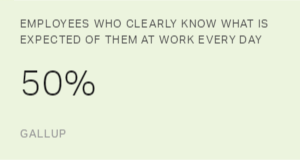Story Highlights
- Few people say managers help them set performance goals
- Companies must remove cultural barriers to performance
- Leaders have to align people, processes and systems
This is the second article in a two-part series on the role of great managers in improving performance management systems.
When it comes to managing performance, managers have their work cut out for them. Few employees feel their manager excels at even the most basic performance management tasks.
Gallup's State of the American Manager report noted that only 12% of employees strongly agree that their manager helps them set work priorities, and just 13% strongly agree that their manager helps them set performance goals.
For executive leaders, driving organizational performance is easier said than done -- it requires everything from hiring great managers to developing a strong culture. There are so many elements to align that even the best performance strategy can get lost in the execution. As a result, executives sometimes default to bad performance management processes.
Other leaders delegate performance management responsibilities to HR, assuming that an HR-facilitated process will help improve the state of performance. Yet it often doesn't, because many HR people haven't cracked the performance management code -- great managers, effective and efficient processes and metrics, and a high-performance culture.
But leaders who are devoted to growth and performance take a different approach. For the past 40 years, Gallup has studied high-performing organizations and advised leaders on how to develop and sustain them. We've learned that organizations deliver precisely what their purpose, brand and culture support -- whether that's excellence or dysfunction. This means that leaders can increase performance by being intentional about things like organizational alignment and clarity.
Here are some steps leaders committed to building a highly successful organization can take to deliver performance:
Clarify your purpose and brand. To align purpose and brand, leaders need to clearly know and communicate why the organization exists and what they want to be known for. Clarity of purpose at all levels -- enterprise, line-of-business and unit -- is necessary for building an organizational culture that performs at top levels. For example, Southwest Airlines and Google provide rich case studies of companies that entered crowded markets and differentiated themselves among customers and employees based on their purpose and brand.
Remove cultural barriers to performance. Gallup's ongoing organizational effectiveness research has identified five functional drivers of a strong organizational culture: leadership and communication, values and rituals, human capital practices and policies, work teams and structures, and performance. These are concrete aspects of an organization's culture that leaders can measure and manage. Among these five drivers, barriers to performance reveal themselves in several ways. Here are some common obstacles Gallup has helped clients overcome:
- executive team misalignment
- lack of commitment to change
- lack of role clarity
- inconsistency in strategy execution
- misaligned organizational design
- misunderstanding of values that undermine performance
Executives and senior leaders are the only people with sufficient authority for removing cultural barriers to performance -- and it's critical that they exercise this authority.
Study your stars. Identifying top performers is one thing; studying them is another. Observing and measuring what excellence looks like in a role is the best way to define successful performance, which means it's vital for leaders to know what their best do differently. Top performers can provide a wealth of information about what makes the company attractive to talented people, how employees want to be managed and how to further each employee's success. By studying star performers, leaders can ensure that their strategies for selecting and developing employees are on target.
Use predictive analytics to hire for excellence. Predictive analytics empower leaders with insights and information for ensuring employees and managers possess the innate talents they need to excel in their roles. For example, although true manager talent is rare, it does exist, and organizations can identify and measure it. To find talented managers and employees, leaders need to develop the right strategy and use a systematic approach to scientifically choose top performers and great managers.
Align people and processes. Dr. W. Edwards Deming, the father of total quality management, taught that bad systems beat good people. Yet Gallup's research shows that great managers lead differently and get better results from their employees -- even with broken performance systems. Ultimately, the responsibility for bringing people and processes together falls on executive leaders. Leaders need to take ownership of ensuring that success is built into the systems their companies use to drive performance -- and that employees at all levels understand and connect with performance-building efforts. By keeping people, processes and systems in harmony, leaders do their part to ensure that their organization's approach to performance management is the best it can be.
As highlighted in the first article of this two-part series, great managers catalyze team performance, making manager talent a crucial component of performance management. When executives combine manager talent with essential performance-driving practices and metrics, they complete the performance management puzzle. This full-scale approach can help any leader fortify a high-performing organization from the inside out and ensure that it is built to last.


